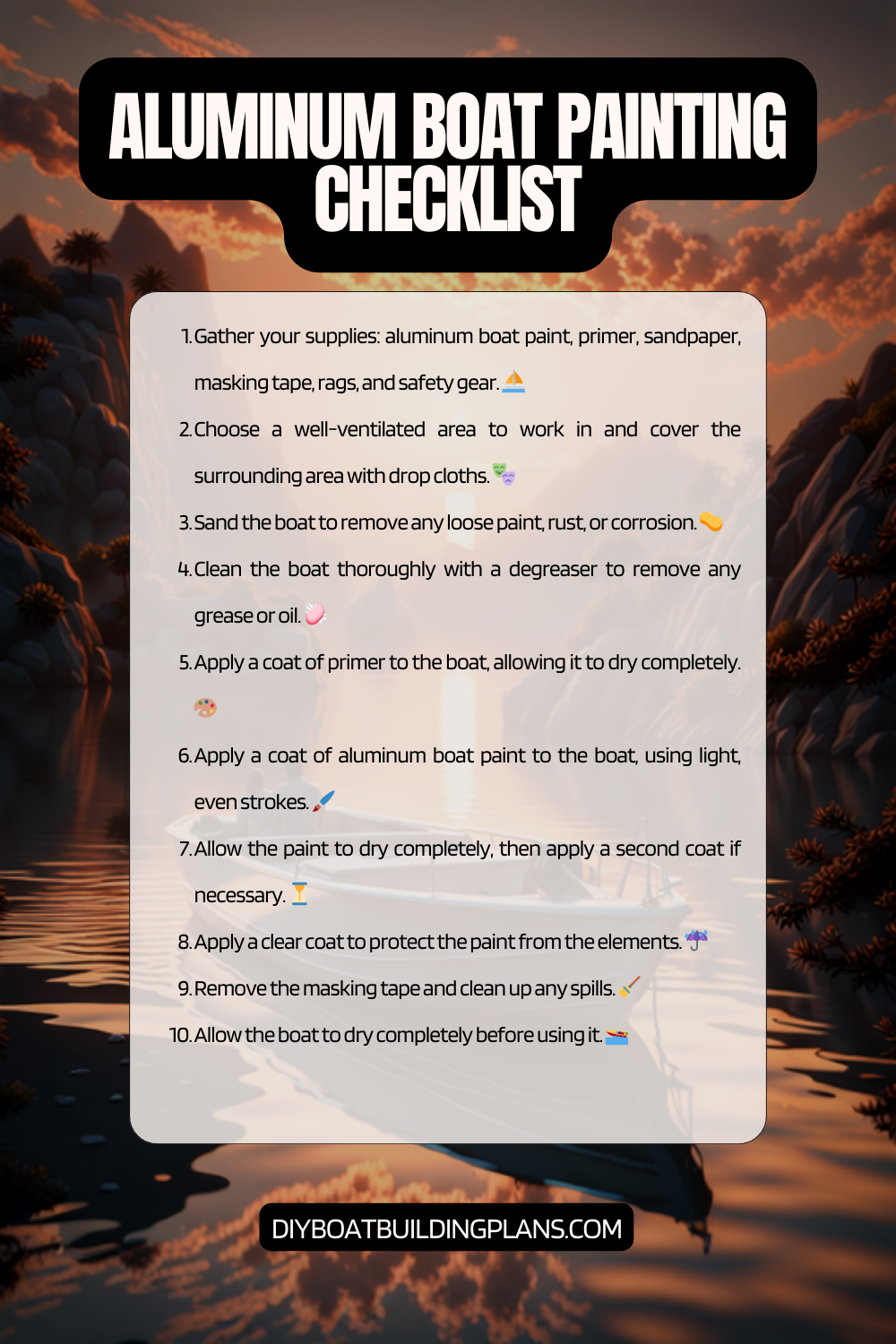Overview of Aluminum Boat Painting Tips
Painting an aluminum boat is an essential task for boat owners who want to protect their investment and maintain its appearance. Aluminum boats are popular for their durability and resistance to corrosion, but over time, they can still be susceptible to damage from the elements. In this article, we will explore the importance of painting an aluminum boat and provide a comprehensive guide on how to do it effectively. From choosing the right paint to maintaining the paint job, we will cover all the necessary steps to ensure a long-lasting and visually appealing finish.
Key Takeaways
- Painting your aluminum boat can protect it from corrosion and improve its appearance.
- Choose a marine-grade paint that is specifically designed for use on aluminum boats.
- Proper preparation, including cleaning and sanding, is crucial for a successful paint job.
- Use high-quality brushes and rollers to apply the paint evenly and achieve a smooth finish.
- Regular maintenance, including washing and waxing, can extend the life of your boat’s paint job.

Why Paint Your Aluminum Boat?
There are several benefits to painting an aluminum boat. Firstly, it provides protection against corrosion and other damages caused by exposure to water, salt, and UV rays. Aluminum is naturally resistant to corrosion, but painting it adds an extra layer of defense, preventing oxidation and extending the lifespan of the boat. Additionally, a well-painted boat is more visually appealing and can significantly enhance its resale value. A fresh coat of paint can make an old boat look brand new, attracting potential buyers and increasing its marketability.
Choosing the Right Paint for Your Aluminum Boat
When it comes to choosing the right paint for your aluminum boat, there are a few factors to consider. Firstly, you need to select a paint that is specifically formulated for use on aluminum surfaces. These paints are designed to adhere well to aluminum and provide long-lasting protection. Additionally, consider the type of finish you desire – whether it’s glossy or matte – as this will affect your choice of paint. Some recommended brands for painting aluminum boats include Interlux, Pettit, and Rust-Oleum Marine.
Preparing Your Aluminum Boat for Painting
| Step | Description |
|---|---|
| 1 | Clean the boat thoroughly with soap and water to remove any dirt, grime, or debris. |
| 2 | Sand the boat’s surface with a fine-grit sandpaper to create a smooth surface for painting. |
| 3 | Apply a coat of primer to the boat’s surface to help the paint adhere better. |
| 4 | Allow the primer to dry completely before applying the paint. |
| 5 | Apply the paint in thin, even coats, allowing each coat to dry completely before applying the next. |
| 6 | Apply a clear coat to protect the paint and give it a glossy finish. |
| 7 | Allow the boat to dry completely before using it. |
Proper preparation is crucial for achieving a successful paint job on your aluminum boat. Before you start painting, make sure to thoroughly clean the boat’s surface to remove any dirt, grime, or contaminants that could affect the adhesion of the paint. Use a mild detergent and a soft brush to scrub the boat, paying extra attention to areas that are prone to buildup, such as the hull and deck. Once the boat is clean, rinse it thoroughly with water and allow it to dry completely.
Cleaning and Sanding Your Aluminum Boat
After cleaning, the next step is to sand the boat’s surface to create a smooth and even base for the paint. Start by using a medium-grit sandpaper to remove any loose paint, rust, or imperfections. Be sure to wear protective gloves and a mask to avoid inhaling any dust particles. Once the loose paint and rust are removed, switch to a finer-grit sandpaper to achieve a smoother finish. Sand in a circular motion, paying attention to any rough areas or edges. After sanding, wipe down the boat with a clean cloth to remove any residual dust.
Applying Primer to Your Aluminum Boat
Priming your aluminum boat is essential for ensuring proper adhesion of the paint and enhancing its durability. Primer acts as a bonding agent between the boat’s surface and the paint, creating a strong foundation for the final coat. There are different types of primers available for aluminum boats, including etching primers and self-etching primers. Etching primers are recommended for bare aluminum surfaces, while self-etching primers are suitable for painted or previously coated surfaces. Apply the primer evenly using a brush or roller, following the manufacturer’s instructions.
Choosing the Right Paintbrushes and Rollers
Choosing the right tools for painting your aluminum boat can make a significant difference in achieving a professional-looking finish. For smaller areas or intricate details, use high-quality brushes with synthetic bristles that are specifically designed for marine applications. Look for brushes that have good paint-holding capacity and provide smooth application without leaving brush marks. When it comes to larger areas, such as the hull or deck, opt for foam or microfiber rollers. These rollers ensure even coverage and minimize the appearance of roller marks.
Applying Paint to Your Aluminum Boat
When applying paint to your aluminum boat, it’s important to use proper techniques to achieve a smooth and flawless finish. Start by pouring the paint into a paint tray and load your brush or roller evenly. Apply the paint in thin, even coats, working in one direction to avoid overlapping brush strokes. It’s better to apply multiple thin coats rather than one thick coat, as this reduces the risk of drips and runs. Allow each coat to dry completely before applying the next one, following the manufacturer’s recommended drying time.
Tips for Achieving a Smooth Finish
To achieve a smooth finish on your aluminum boat, there are a few additional techniques you can employ. Firstly, make sure to sand between coats using a fine-grit sandpaper. This helps to remove any imperfections or rough spots and creates a smooth surface for the next coat of paint. Additionally, consider using a foam brush or roller for the final coat, as these tools tend to leave fewer brush marks or roller lines. Finally, invest in high-quality paint products that are specifically formulated for marine applications. These paints often have self-leveling properties that help to minimize imperfections and create a professional-looking finish.
Download over 500 Boat Plans. Click on the link below.
-->Click Here<--
Maintaining Your Aluminum Boat’s Paint Job
Once you have successfully painted your aluminum boat, it’s important to maintain its appearance and protect the paint job from premature wear and tear. Regular cleaning is essential to remove dirt, salt, and other contaminants that can degrade the paint over time. Use a mild detergent and a soft brush or sponge to clean the boat, avoiding abrasive cleaners that can damage the paint. Additionally, consider applying a protective wax or polish to further enhance the boat’s shine and provide an extra layer of protection against UV rays and oxidation.
Common Mistakes to Avoid When Painting Your Aluminum Boat
While painting an aluminum boat can be a rewarding task, there are some common mistakes that boat owners should avoid. One of the most common mistakes is not properly preparing the boat’s surface before painting. Failing to clean and sand the boat can result in poor adhesion and a less durable finish. Another mistake is applying too thick of a coat of paint, which can lead to drips, runs, and an uneven finish. It’s important to follow the manufacturer’s instructions regarding the recommended number of coats and drying times.
Aluminum Boat Painting Checklist

Conclusion – Aluminum Boat Painting Tips
In conclusion, painting an aluminum boat is a worthwhile investment that provides protection against corrosion, enhances its appearance, and increases its resale value. By choosing the right paint, properly preparing the boat’s surface, and using the correct tools and techniques, you can achieve a professional-looking finish that will stand the test of time. Remember to maintain your boat’s paint job through regular cleaning and maintenance, and avoid common mistakes that can compromise the quality of your work. With these tips in mind, you can enjoy a beautifully painted aluminum boat for years to come.
FAQs – Aluminum Boat Painting Tips
What is aluminum boat painting?
Aluminum boat painting is the process of applying paint or coating to the surface of an aluminum boat to protect it from corrosion, fading, and other forms of damage.
Why is it important to paint an aluminum boat?
Painting an aluminum boat is important because it helps to protect the boat from the harsh marine environment, including saltwater, UV rays, and other elements that can cause damage to the boat’s surface.
What are some tips for preparing an aluminum boat for painting?
Some tips for preparing an aluminum boat for painting include cleaning the surface thoroughly, removing any old paint or coatings, sanding the surface to create a smooth surface, and applying a primer to help the paint adhere to the surface.
What types of paint are best for painting an aluminum boat?
The best types of paint for painting an aluminum boat are epoxy-based paints, polyurethane paints, and marine-grade enamel paints. These types of paints are durable, long-lasting, and resistant to fading, chalking, and other forms of damage.
How many coats of paint should be applied to an aluminum boat?
Typically, two to three coats of paint are recommended for painting an aluminum boat. However, the number of coats required may vary depending on the type of paint used, the condition of the boat’s surface, and other factors.
How long does it take to paint an aluminum boat?
The time it takes to paint an aluminum boat will depend on the size of the boat, the condition of the surface, and the number of coats of paint required. Generally, it can take anywhere from a few days to a few weeks to complete the painting process.



